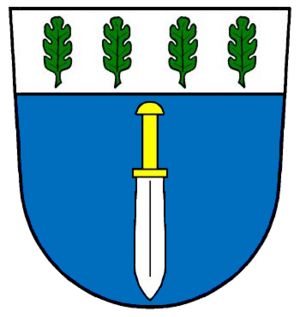Seax facts for kids
The seax (pronounced "sacks") is an Old English word for "knife." Today, when archaeologists talk about a seax, they mean a special kind of small sword, knife, or dagger. These weapons were common among Germanic people during the Migration Period and Early Middle Ages. They were especially used by the Saxons, who even got their name from this weapon! Seaxes came in many different sizes.
You might also see a seax in heraldry, which is the study of coats of arms. Here, a seax is a curved sword with a notched blade. For example, it appears on the coats of arms for Essex and the old county of Middlesex in England.
What's in a Name?
The word seax comes from Old English. Similar words like sax in Old Frisian, and sahs in Old Saxon and Old High German, all mean the same thing. These words all come from an even older Germanic word, *sahsą, which means "to cut." This is also where the word "saw" comes from!
In countries like Scandinavia, words like sax, saks, or sakset are used for scissors, which are tools used for cutting.
Sometimes, you might hear the word scramaseax. This means "wounding-knife." It's not an Old English word, but it was used by a historian named Gregory of Tours when he wrote about the Franks. Even the name of a roofer's tool, the zax, developed from the word seax.
What Did a Seax Look Like?
Seaxes came in many different shapes and designs. But most of them shared some common features:
- They had a part called a tang in the middle of the blade. This tang was pushed into a handle made of natural materials like wood or animal horn.
- They had a large blade with only one sharp edge.
- People usually wore the seax horizontally (sideways) in a scabbard (a sheath) attached to their belt. The sharp edge of the blade would point upwards.
Historians have identified different types of seaxes used by Germanic people in mainland Europe between about 450 and 800 AD. Here are some of them, listed in the order they appeared:
- Narrow long seax
- Short seax
- Narrow seax: These often had cool designs like braided patterns or snakes carved into the blade. They also frequently had metal parts on the handle. Both the sharp edge and the back of the blade curved towards the tip, which was usually above the center line of the blade.
- Light broad seax: These were similar to narrow seaxes but often had simpler designs, like parallel lines, and usually didn't have metal parts on the handle. Both the edge and the back curved towards the tip, which was usually right at the center line of the blade.
- Heavy broad seax: These had very simple designs, if any. They had long handles (over 20 cm or 8 inches) made from one piece of natural material. Like the light broad seax, both the edge and the back curved towards the tip, which was at the center line.
- Atypical broad seax: These were similar to the heavy broad seax.
- Long seax: These were the longest seaxes, with blades 50 cm (20 inches) or more. They often had special patterns in the metal (called pattern welded) and long handles. The edge was usually straight or curved only a little towards the tip. The back of the blade either curved gently or had a sharp angle towards the tip, which was below the center line.
Over time, seax blades generally became heavier, longer, wider, and thicker. The long seaxes, which appeared in the late 600s, were the longest type. However, they were actually narrower and lighter than the broad seaxes that came before them.
At first, seaxes were often found alongside double-edged swords. They were probably used as a smaller side weapon. But from the 600s onwards, seaxes became the main cutting weapon, sometimes used with small side-knives.
Other parts of Europe (except some parts of Scandinavia) saw similar changes in seax design. In England, long seaxes appeared later than on the continent. Finding long seaxes in England is also much rarer compared to finding swords from the same time.
Another unique type of seax is called the broken-back seax. These seaxes have a sharp, angled bend where the back of the blade meets the point. This point usually makes up about one-third to three-fifths of the blade's total length, much like a modern clip-point blade. Broken-back seaxes were mostly found in the United Kingdom and Ireland, with some examples in Germany from the 700s to the 1000s. Some of these had pattern-welded blades, and others had designs made with silver, copper, or brass.
See Also
- Kragehul lance
- Migration Period sword
- Migration Period spear
- Seax of Beagnoth






